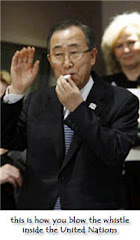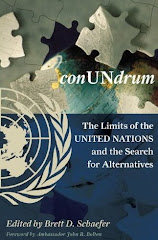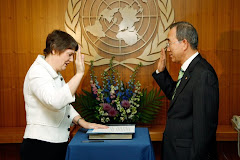
The Intergovernmental Panel on Climate Change (IPCC) in its report noted that this can only happen if global greenhouse gas emissions peak by 2015 and rich nations slash their carbon pollution levels by 25 percent - 40 percent from 1990 levels by 2020.
Since the Copenhagen climate change summit last December 2009, 100 countries have submitted individual emission cut targets to the UN Framework Convention on Climate Change (UNFCCC).
The Copenhagen Accord sets a non-binding goal of limiting global warming to below 2 degrees Celsius (3.6 Fahrenheit) above pre-industrial times and a goal of $100 billion in aid from 2020.
However, many parties believe that outcome of the Copenhagen conference fell far short of what is needed to address climate change.
Gas emission cut pledges listed in the Copenhagen Accord might not be enough if the world wants to limit earth temperature rise to two degrees. according to UNEP.
Luckily, there are still opportunities to increase the targets but countries need to define longer targets than in 2020, said United Nations Environment Program (UNEP)
Executive Director Achim Steiner at a meeting held in Bali, last February.
Countries will have to be far more ambitious in cutting greenhouse gas emissions if the world is to effectively keep tha rise in global temperature at a maximum of two degrees Celsius or less, according to a new greenhouse gas modeling study based on the estimates of researchers at nine leading centers compiled by UNEP.
The experts suggested that annual global greenhouse gas emissions should not be larger than 40 to 48.3 Gigatonnes (Gt) of CO2 equivalent in 2020 and should peak some time between 2015 and 2021.
"Such a path offers a `medium` likelihood or at least a 50/50 chance of keeping a global temperature rise at below two degrees C," said the UNEP report launched on the sidelines of the Simultaneous Extraordinary Meetings of the Conferences of the Parties (ExCOPs) to the Basel, Rotterdam and Stockholm Conventions being held at the Bali International Convention Center, Nusa Dua, February 22-24, 2010.
The new study has analyzed the pledges of 60 developed and developing economies.
"The expected emissions for 2020 range between 48.8 to 51.2 GT of CO2 equivalent based on whether high or low pledges will be fulfilled," said the report entitled "How Close Are we to the Two Degree Limit?".
Meanwhile, emissions in 2020 needed to be between 40 Gt and 48.3 Gt in order to meet the 2 degree C aim in 2050, the report noted.
Thus even with the best intentions, the gap would be between 0.5 and 8.8 Gt of CO2 equivalent per year, amounting to an average shortfall in emission cuts of 4.7 Gt.
If the low end of the emission reduction pledges are fulfilled, the gap would be even bigger, namely 2.9 Gt to 11.2 Gt of CO2 equivalent per year, with an average gap of 7.1 Gt, said the report.
"There are clearly a great deal of assumptions underlying these figures, but they do provide an indication of where countries are and perhaps more importantly where they need to aim," Achim Steiner said.
Indonesian Assistant Minister for Global Environmental Affairs Liana Bratasida told the Indonesian press in the Bali meeting, that the pledges by developing countries were basically adequate, but not so with developed countries` emission cut targets.
The Indonesian government has pledged to cut gas emissions by 26 percent in 2020 and by 41 percent with international support.
"In the spirit of thinking outside the box, in September this year Indonesia declared an emission reduction target of 26 percent of `business as usual` by 2020, and this can be increased to 41 percent with enhanced international assistance," President Susilo Bambang Yudhoyono said in his speech before participants of the UNFCCC (United Nations Framework Convention on Climate Change), in Copenhagen in December 2009.
From Kuala Lumpur, Bernama news agency reported that Malaysia`s Natural Resources and Environment Minister Douglas Unggah Embas on Monday (March 22) told the House of Representatives that Carbon dioxide emission can be reduced to 40 percent by 2020.
Douglas Unggah said the government was confident of achieving the target since an initial strategy to draft a roadmap, comprising three main programmes - conserve energy, renewal energy and waste management - had already started.
China has announced a target of reducing carbon emissions per unit of GDP by 40 to 45 percent from 2005 levels by 2020. India went next with a carbon intensity reduction target of 20 to 25 percent below 2005 levels by 2020.
While, the US has promised to agree to 2020 emissions cuts `in the range of` 17 percent below 2005 levels. It falls very far short of the European Union`s 2020 commitment to reduce emissions by 20 percent below 1990 levels, yet still considered inadequate.
However, Juergen Lefevere, an official at the European Commission`s Directorate-General for Climate Action, said at a press conference in Tokyo, early March 2010 that the European Union would discuss raising its target to reduce greenhouse-gas emissions to 30 percent from 20 percent regardless of whether other countries agree to specific goals, a European Commission official said.
EU countries will discuss whether a more aggressive target for emissions cuts will be in their economic interests in terms of energy efficiency and security as well as gaining an advantage in moving first on green technology, he said.
Hopes on higher emission cut pledges are high on the agenda of the Cancun Climate Change Summit which will be organized by the Mexican government, on November 29-December 10, 2010. (*)
















































No comments:
Post a Comment